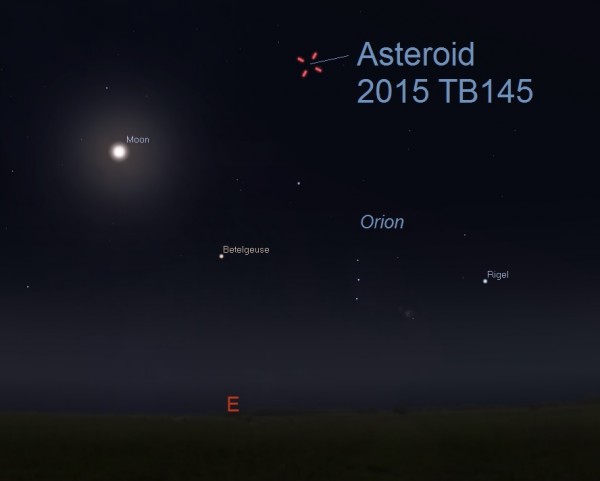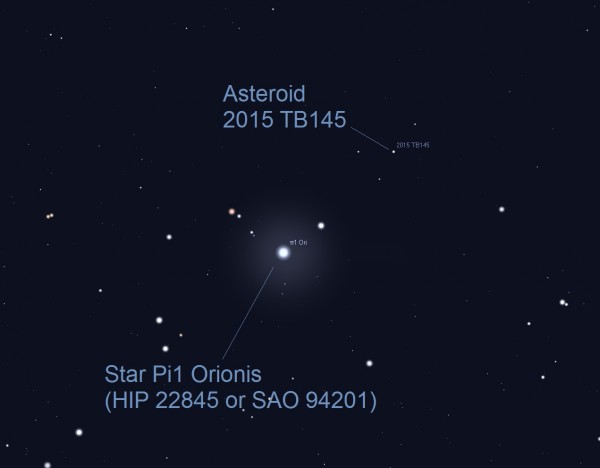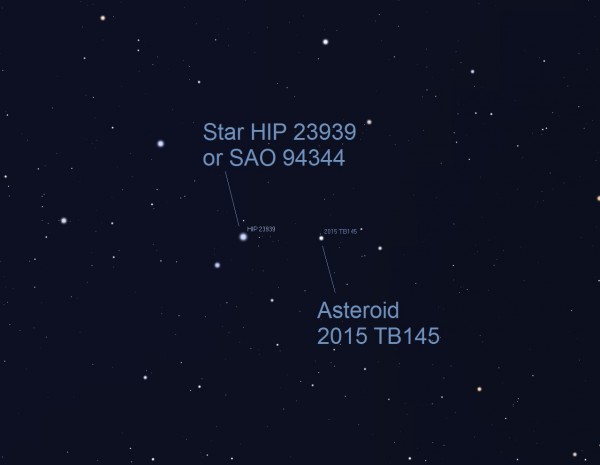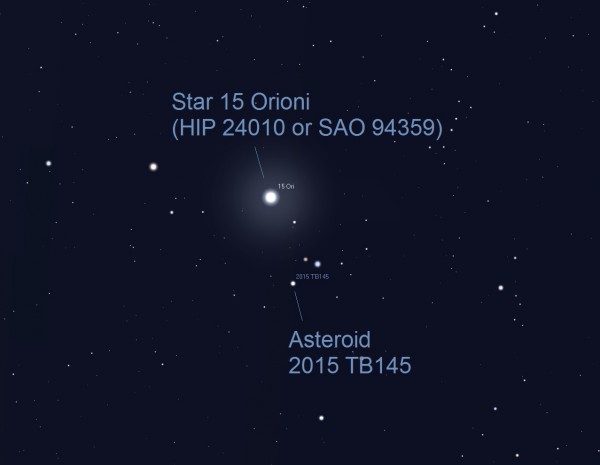Update: Close pass of Halloween asteroid
Friday night is the best time to view asteroid 2015 TB145 with a telescope. Updated charts and tips for observers – plus info on this close-passing asteroid – here.
View larger. | This graphic depicts the orbit of asteroid 2015 TB145. Image via NASA/JPL-Caltech.
UPDATE OCTOBER 30, 2015. A newly found asteroid of notable size – known as asteroid 2015 TB145 – will safely pass Earth on October 31, 2015, according to clocks in North America. It should be visible moving in front of the stars, with the help of a telescope, tonight (October 30). It is the biggest known asteroid that will come this close Earth until 2027. The asteroid – found as recently as October 10 – will fly past Earth at a safe distance, or about 1.3 times the moon’s distance. Closest approach to Earth will be October 31 at 1 p.m. EDT (1700 UTC). Translate to your time zone here. Follow the links below for charts and other information.
Top tips and charts for viewing the asteroid with a telescope.
How close will asteroid 2015 TB145 come to the Earth and moon?
How big is it?
When and how did scientists discover asteroid 2015 TB145?
How will scientists observe it?
Similar close approaches of other asteroids
When will asteroid 2015 TB145 sweep near Earth again?

Facing east from U.S. at 11:50 pm ET October 30, 2015 (late on Friday night). Illustration by Eddie Irizarry using Stellarium.
Top tips and charts for viewing the asteroid with a telescope. Asteroid 2015 TB145 won’t be visible to the eye alone. Observers trying to glimpse the space rock using telescopes will have to look late at night of October 30, and before dawn on October 31.
The space rock’s brightness will be at an approximate magnitude of 10. It should be easy to spot “slowly” moving across the field of stars if you know when and where to look. On the night of October 30-31, the asteroid will be traveling across the well-known constellation of Orion. Because of its large size, advanced amateur astronomers might be able to see the movement of the asteroid in telescopes of 8″ in diameter or larger.
And, by the way, although the asteroid’s distance will make this moving object appear to move slowly, this speeding space rock is traveling at 78,000 miles (126,000 km) per hour!
More tips and charts for observers below:

Asteroid position at 11:20 ET (0320 UTC) on October 30. If you have a computerized (Go To) telescope, point it to HIP 22845 or SAO 94201, a 4th magnitude star in Orion before 11:20 p.m. ET Friday night, and wait for the asteroid. The space rock will appear as a slowly moving ‘star’ passing very close to this actual fixed star at that time. This view shows a half degree field of view (about the size of a full moon). Alternatively, you can point your telescope to these coordinates: RA 04h 54m 53.755 s / DEC +10º 09′ 02.60″. Illustration by Eddie Irizarry using Stellarium.

Asteroid position at 12:05 a.m. ET (0405 UTC) on October 31. Point a Go To computerized telescope to HIP 23035 or SAO 94225, a 7th magnitude star in Orion. On Saturday morning at 12:05 a.m. ET, the space rock passes close to this star. The asteroid will appear as a slowly moving ‘star’ passing close to this star. This illustration shows a half degree field of view (about the size of a full moon). Alternatively, you can point your telescope to these coordinates: RA 4h 57m 13.1s / DEC +10º 48′ 35.5″. Illustration by Eddie Irizarry using Stellarium.
1. Although the asteroid may be visible with smaller telescopes, its motion should be easier to see by advanced amateur astronomers using an 8″ or bigger diameter telescope.
2. Note that the asteroid’s nearness to Earth at the time of closest approach might cause a parallax effect. That means the space rock’s apparent nearness on our sky’s dome to a fixed star might differ slightly, as seen from different locations across Earth. Thus, if you don’t see the asteroid at the expected time, scan one more field of view up and down from your reference star, that is, the star you are waiting to see the asteroid to pass by.
3. A wide-angle eyepiece can be initially used for the asteroid search; however a medium power eyepiece such as a 17mm will show better the motion of this asteroid.
4. Remember that you will be looking for an apparent “moving star” slowly passing in front of actual fixed stars visible in a telescope. If you are using an 8″ telescope with a 17mm eyepiece, at around 2:20 a.m. CT on Saturday, October 31 the asteroid’s motion should cover the entire field of view in about 7 minutes. A few hours later it will appear to move faster because the asteroid will be getting closer to us.
5. Because the moon’s presence will illuminate your observing session, it is a good idea to cover your head with dark clothes or a black t-shirt while observing. This will let you have a better view of only what is visible though the eyepiece of the telescope and avoid distractions.

Asteroid position at 1:30 a.m. ET (5:30 UTC). Point a Go To computerized telescope to HIP 23382 or SAO 94272, a 7 magnitude star in Orion before 1:30 a.m. ET Saturday morning Saturday morning and wait for the asteroid. Field of view half a degree. Alternatively, you can point your telescope to these coordinates: RA 05h 01m 36.8 s / DEC +12º 20′ 25.4″. Illustration by Eddie Irizarry using Stellarium.

Asteroid position at 2:55 a.m. ET (655 UTC). Point a Go To computerized telescope to HIP 23786 or SAO 94322, a 7th magnitude star in Orion. At 2:55 a.m. ET on Saturday morning, the space rock passes very close to this star. The asteroid will appear as a slowly moving ‘star’ passing close to this star. View of view half a degree. Alternatively, you can point your telescope to these coordinates: RA 5h 06m 42.5s / DEC +14º 26′ 42.7″. Illustration by Eddie Irizarry using Stellarium.

Asteroid position at 3:20 a.m. ET (7:20 UTC). Point a Go To computerized telescope to HIP 23939 or SAO 94344, an 8 magnitude star in Orion. At 3:20 a.m. ET on October 31 (Saturday morning), the space rock passes very close to this star. The asteroid will appear as a slowly moving ‘star’ passing close to this star. This illustration shows a half degree field of view (about the size of a full moon). Alternatively, you can point your telescope to these coordinates: RA 5h 8m 42.3s / DEC +15º 06′ 13.6″. Illustration by Eddie Irizarry using Stellarium.

Asteroid position at 3:35 ET (0735 UTC). Point to 15 Orionis (HIP 24010 or SAO 94359) a naked-eye star with a magnitude of 4.8 in Orion. At 3:35 a.m. ET Saturday morning, the space rock passes close to this star. The asteroid will appear as a slowly moving ‘star’ passing very close to this star. By this time the asteroid should appear to move faster because it will be closer to Earth than earlier on the night of October 30. Field of view half a degree. Alternatively, you can point your telescope to these coordinates: RA 05h 09m 42.0s / DEC +15º 35′ 49.8″. Illustration by Eddie Irizarry using Stellarium.

Asteroid position at 3:50 a.m. ET (0750 UTC) Point a Go To computerized telescope to HIP 24197 or SAO 94377) a naked-eye star with a magnitude of 5 in Orion. At 3:50 a.m. ET on October 31 (Saturday morning), the space rock passes close to this star. The asteroid will appear as a slowly moving ‘star’ passing very close to this star. By this time the asteroid should appear to move faster because it will be closer to Earth than earlier on the night of October 30. This illustration shows a half degree field of view (about the size of a full moon). A pair of double stars visible in this area should confirm you are pointing at the correct direction. Alternatively, you can point your telescope to these coordinates: RA 05h 11m 41.6s / DEC +16º 02′ 44.5″. Illustration by Eddie Irizarry using Stellarium.
How close will asteroid 2015 TB145 come to the Earth and moon? The huge asteroid will pass Earth at 310,000 miles (498,896 km) or 1.3 times the Earth-moon distance, which is a totally safe pass.
It’ll come closer to the moon than to Earth, only 180,000 miles (280,000 km) from the moon.
Paul Chodas, manager of the Center for Near Earth Object Studies at NASA’s Jet Propulsion Laboratory, Pasadena, California, said:
How big is it? Scientists are continuing to estimate the size at 1,300 feet (400 meters) wide.The trajectory of 2015 TB145 is well understood. At the point of closest approach, it will be no closer than about 300,000 miles – 480,000 kilometers or 1.3 lunar distances. Even though that is relatively close by celestial standards, it is expected to be fairly faint, so night-sky Earth observers would need at least a small telescope to view it.
If the size is correct, the new found asteroid is 28 times bigger in diameter than the Chelyabinsk meteor that penetrated the atmosphere over Russia in February, 2013. An incoming asteroid’s potential to do damage on Earth depends on various factors, including its size, its angle of entry, and the point on Earth over which it enters the atmosphere. The shock wave from the 2013 Chelyabinsk meteor broke windows and did other damage to some 7,200 buildings in six Russian cities. Some 1,500 people were injured seriously enough to seek medical treatment, mainly from broken glass from windows.
When and how did scientists discover asteroid 2015 TB145? They first spotted it on October 10, 2015 with the Pan-STARRS I telescope in Hawaii.
Because it was discovered so recently, only three weeks before its closest encounter with Earth, it is fortunate that asteroid 2015 TB145 is passing at a safe distance.
It’s a reminder of a comment made by NASA Administrator Charles Bolden in March, 2013, while addressing the U.S. House Science, Space, and Technology Committee at a meeting to discuss the threat of incoming asteroids like the Chelyabinsk meteor, which had happened just a month earlier. Bolden was trying to emphasize the need for adequate U.S. funding for detecting and characterizing near-Earth objects, and diverting them if necessary, when he told the committee:
Asteroid 2015 TB145, too – a large asteroid, discovered so recently – is a reminder of how important it is to support and improve the asteroid detection programs, such as NASA’s Near-Earth Object program. It’s also important to continue scientific studies about what might be done if a dangerous asteroid is detected on a possible collision course with Earth.From the information we have, we don’t know of an asteroid that will threaten the population of the United States. But if it’s coming in three weeks … pray.
Various space agencies are already working towards earlier asteroid detections, but more funding is always required.
NASA is also planning to catch an asteroid, move it closer to our moon’s orbit, and then send astronauts to study how we can change the space rock’s orbit.
Goldstone – near Barstow, California – is the largest tracking station in NASA’s Deep Space Network, which is composed of three installations located at roughly 120-degree intervals around the globe (with one at Madrid, Spain, and another at Canberra, Australia) for a continuous view of space. Image via Land Use Data Base.
How will scientists observe asteroid 2015 TB145? NASA scientists said this week they are now tracking the upcoming Halloween flyby of this asteroid with several optical observatories and the radar capabilities of the agency’s Deep Space Network at Goldstone, California.
Lance Benner of the Jet Propulsion Laboratory in Pasadena, California, who leads NASA’s asteroid radar research program, said in a story at JPL’s website:
He added that this object might not be an asteroid at all, but instead “some type of comet.” Comets tend to have more elongated orbits than asteroids. They tend to be icy, rather than rocky or metallic, bodies. Benner said:The close approach of 2015 TB145 at about 1.3 times the distance of the moon’s orbit, coupled with its size, suggests it will be one of the best asteroids for radar imaging we’ll see for several years. We … hope to see unprecedented levels of detail.
Similar close approaches of other asteroids. NASA has said asteroid 2015 TB145 is the biggest known space rock to pass near Earth until 2027, when asteroid 1999 AN10 will safely pass by Earth:The asteroid’s orbit is very oblong with a high inclination to below the plane of the solar system. Such a unique orbit, along with its high encounter velocity – about 35 kilometers or 22 miles per second – raises the question of whether it may be some type of comet. If so, then this would be the first time that the Goldstone radar has imaged a comet from such a close distance.
In January, 2015 another asteroid, BL86 came some 1.2 million km (745,000 miles) from our planet. The 325 meter (1,100 ft) was also seen moving across the stars though telescopes.According to the catalog of near-Earth objects (NEOs) kept by the Minor Planet Center, this is the closest currently known approach by an object this large until asteroid 1999 AN10, at about 2,600 feet (800 meters) in size, approaches at about 1 lunar distance (238,000 miles from Earth) in August 2027.
Since asteroid 2015 TB145 appears to be bigger, and will pass even closer, its movement may be easier to spot than was the motion of asteroid BL86.
When will asteroid 2015 TV145 sweep near Earth again? [url=http://ssd.jpl.nasa.gov/sbdb.cgi?sstr=2015 tb145;orb=1;old=0;cov=0;log=0;cad=1#cad]According to NASA[/url], after this Halloween (October 31, 2015), the next sweep of the asteroid past Earth will be on [url=http://ssd.jpl.nasa.gov/sbdb.cgi?sstr=2015 tb145;orb=1;old=0;cov=0;log=0;cad=1#cad]November 10, 2018[/url], but, at that time, the asteroid will be nearly 25 million miles (40 million km) away. A closer encounter will take place in the year 2152.

Artist’s concept of a large asteroid passing Earth, via Shutterstock.
Bottom line: Asteroid 2015 TB145 – largest known space rock to sweep near Earth until 2027 – will pass about 1.3 times the moon’s distance on October 31, 2015. This post contains information on the asteroid’s estimated size, its closest approach to the Earth and moon, tips for observing it with a telescope, how scientists intend to observe it, other close approaches of similarly sized asteroids, and more.
Thanks to: http://earthsky.org






 Sat Mar 23, 2024 11:33 pm by globalturbo
Sat Mar 23, 2024 11:33 pm by globalturbo

